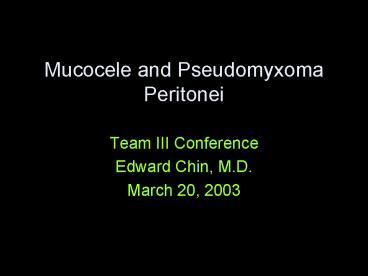Team III Conference - PowerPoint PPT Presentation
1 / 27
Title:
Team III Conference
Description:
Obstruction 2nd hyperplasia or fecalith. Presentation depends on nature/degree of obstruction: ... Fecalith acute inflammation, with mucinous content. Mucoceles: ... – PowerPoint PPT presentation
Number of Views:80
Avg rating:3.0/5.0
Title: Team III Conference
1
Mucocele and Pseudomyxoma Peritonei
- Team III Conference
- Edward Chin, M.D.
- March 20, 2003
2
Case
- 60M with hematuria on routine U/A
- Hx reveals abdominal pain x 3 months
- Benign abdominal exam
- CT scan
3
(No Transcript)
4
(No Transcript)
5
(No Transcript)
6
Workup
- CT-guided aspiration of pelvic fluid
- Analysis mucinous adenocarcinoma
- Taken to OR on 3/6/03 for exploratory laparoscopy
7
Operative Course
- Diffuse, mucinous material throughout
- Appendiceal mass
- Findings discussed with family
- ? laparotomy
- Appendix, omentum, peritoneum removed
- Larger nodules ablated with ABC
- Tenckhoff catheter placed
8
(No Transcript)
9
Post-operative Course
- Intra-abdominal chemotherapy begun on POD1,
continued x 5 days - Prolonged hospital course 2nd chemo-induced
diarrhea - D/cd POD12
- Pathology well-differentiated invasive mucinous
adenocarcinoma, mucin pools with calcifications
10
Appendiceal Cancer
- 1 of appendectomies contain cancer
- 2/3 carcinoid (50 all GI carcinoids are
appendiceal) - Tan-yellow mass, surrounding desmoplastic
reaction - lt 2 cm ? no further treatment
- gt 2 cm ? R hemicolectomy
- Remainder mucinous cystadenocarcinoma,
adenocarcinoma, adenocarcinoid - Adenocarcinoma associated with metastatic disease
50 of time (likely 2nd appendiceal rupture,
tumor spread)
11
Appendiceal mucocele
- Dilated, mucin-filled appendix
- 0.3 of all appendectomies
- 4 histologic categories
- 1) Retention cyst simple mucocele (normal
mucosa) - 2) Mucosal hyperplasia
- 3) Mucinous cystadenoma ( papillary adenoma
of colon) - 4) Mucinous cystadenocarcinoma
- Contemporary Surgery, 2002 58 (12), 609-613
12
Mucoceles pathophysiology
- Obstruction of appendiceal lumen ? dilation with
mucin - Obstruction 2nd hyperplasia or fecalith
- Presentation depends on nature/degree of
obstruction - Slow, chronic ? large mucocele formation
- Fecalith ? acute inflammation, with mucinous
content
13
Mucoceles natural history
- Asymptomatic (25), vs. chronic RLQ pain vs.
acute appendicitis - Mucocele can also lead to
- Bowel obstruction 2nd intussusception ? cecum
- Torsion ? gangrenous appendix
- Rupture ? mucinous ascites, pseudomyxoma
peritonei - Risk factor for colon cancer (synchronous,
metachronous)
14
(No Transcript)
15
(No Transcript)
16
Differential Diagnosis
- Duplication cyst
- Mesenteric/omental cyst
- Ovarian cyst
- Periappendiceal abscess
17
(No Transcript)
18
Mucoceles treatment
- Hyperplasia, mucinous cystadenoma treated by
simple appendectomy - Malignant mucocele
- Preop/intraop suspicion ? R hemicolectomy, or
appendectomy and frozen section - Post-op diagnosis ? return for definitive
procedure
19
Pseudomyxoma Peritonei
- Extremely rare 300 cases/yr in U.S.
- Diffuse, intraperitoneal collection of gelatinous
fluid with mucinous tumor implants on peritoneal
surfaces and omentum - Strictly, etiology is 2nd grade I mucinous
cystadenocarcinoma of the appendix - Ovarian, pancreatic cancer ? similar picture
20
Pathophysiology
- Mucocele rupture ? dissemination of
mucin-producing tumor cells throughout peritoneal
cavity - Characteristic and predictable pattern of tumor
progression - Gravity ? dependent collection of tumor
- (pelvis, retrohepatic space, paracolic gutters,
Treitz) - 2) Resorption of peritoneal fluid ? accumulation
of tumor cells to distinct sites - Sugarbaker, PA. Histopathology 2001 39,
525-528.
21
Deposit Sites 2nd Fluid Resorption
- 1) Between liver, R hemidiaphragm
- -2nd lymphatics within undersurface of
hemidiaphragm - 2) Greater, lesser omentum
- -lymphatics draw fluid, attracting tumor cells
to their surface ? omental caking - Sugarbaker, PA. Histopathology 2001 39, 525-528
22
Sugarbaker Protocol
- Radical debulking of tumor load
- appendix, peritoneum, omentum
- additional viscera as indicated
- Curative therapy all nodules gt 2.5 mm
- Intraoperative heated mitomycin
- Post-operative 5-FU
- Reports of 80 10 yr survival
23
Rationale for Radical Surgery
- Low aggressiveness of tumor rare LN or liver
involvement - Peritoneal dissemination occurs early
- Areas of spread are treatable by
peritonectomy/omentectomy - Redistribution phenomenon small bowel is largely
spared (2nd motility?) - Regional chemotherapy can attack all surfaces
exposed to tumor - Sugarbaker, PA. EJSO 2001 27 239-243
24
Results
- 385 patients undergoing surgery with intraop
chemo - Post-op tx based on histology
- Mucinous adenoca ? 5 days of 5-FU
- Adenomucinosis ? none
- Morbidity 27, mortality 2.7
- Pancreatitis, EC fistula
- Sugarbaker, PA. EJSO 2001 27 239-243
25
Survival
Sugarbaker, PA. EJSO 2001 27 239-243
26
Survival
Sugarbaker, PA. EJSO 2001 27 239-243
27
Further
- Other reports have 5-year survival of 50-75
- CEA, CA 19-9 of some use in surveillance
- Laparoscopic treatment reported by select
institutions (Cleveland Clinic)































